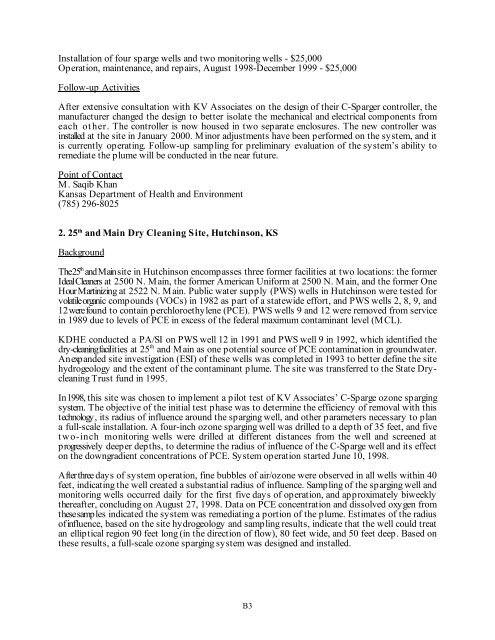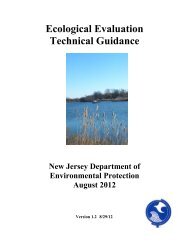Technical and Regulatory Guidance for In Situ Chemical ... - ITRC
Technical and Regulatory Guidance for In Situ Chemical ... - ITRC
Technical and Regulatory Guidance for In Situ Chemical ... - ITRC
You also want an ePaper? Increase the reach of your titles
YUMPU automatically turns print PDFs into web optimized ePapers that Google loves.
<strong>In</strong>stallation of four sparge wells <strong>and</strong> two monitoring wells - $25,000<br />
Operation, maintenance, <strong>and</strong> repairs, August 1998-December 1999 - $25,000<br />
Follow-up Activities<br />
After extensive consultation with KV Associates on the design of their C-Sparger controller, the<br />
manufacturer changed the design to better isolate the mechanical <strong>and</strong> electrical components from<br />
each other. The controller is now housed in two separate enclosures. The new controller was<br />
installed at the site in January 2000. Minor adjustments have been per<strong>for</strong>med on the system, <strong>and</strong> it<br />
is currently operating. Follow-up sampling <strong>for</strong> preliminary evaluation of the system’s ability to<br />
remediate the plume will be conducted in the near future.<br />
Point of Contact<br />
M. Saqib Khan<br />
Kansas Department of Health <strong>and</strong> Environment<br />
(785) 296-8025<br />
th<br />
2. 25 <strong>and</strong> Main Dry Cleaning Site, Hutchinson, KS<br />
Background<br />
th<br />
The 25 <strong>and</strong> Main site in Hutchinson encompasses three <strong>for</strong>mer facilities at two locations: the <strong>for</strong>mer<br />
Ideal Cleaners at 2500 N. Main, the <strong>for</strong>mer American Uni<strong>for</strong>m at 2500 N. Main, <strong>and</strong> the <strong>for</strong>mer One<br />
Hour Martinizing at 2522 N. Main. Public water supply (PWS) wells in Hutchinson were tested <strong>for</strong><br />
volatile organic compounds (VOCs) in 1982 as part of a statewide ef<strong>for</strong>t, <strong>and</strong> PWS wells 2, 8, 9, <strong>and</strong><br />
12 were found to contain perchloroethylene (PCE). PWS wells 9 <strong>and</strong> 12 were removed from service<br />
in 1989 due to levels of PCE in excess of the federal maximum contaminant level (MCL).<br />
KDHE conducted a PA/SI on PWS well 12 in 1991 <strong>and</strong> PWS well 9 in 1992, which identified the<br />
th<br />
dry-cleaning facilities at 25 <strong>and</strong> Main as one potential source of PCE contamination in groundwater.<br />
An exp<strong>and</strong>ed site investigation (ESI) of these wells was completed in 1993 to better define the site<br />
hydrogeology <strong>and</strong> the extent of the contaminant plume. The site was transferred to the State Drycleaning<br />
Trust fund in 1995.<br />
<strong>In</strong> 1998, this site was chosen to implement a pilot test of KV Associates’ C-Sparge ozone sparging<br />
system. The objective of the initial test phase was to determine the efficiency of removal with this<br />
technology, its radius of influence around the sparging well, <strong>and</strong> other parameters necessary to plan<br />
a full-scale installation. A four-inch ozone sparging well was drilled to a depth of 35 feet, <strong>and</strong> five<br />
t wo-inch monitoring wells were drilled at different distances from the well <strong>and</strong> screened at<br />
progressively deeper depths, to determine the radius of influence of the C-Sparge well <strong>and</strong> its effect<br />
on the downgradient concentrations of PCE. System operation started June 10, 1998.<br />
After three days of system operation, fine bubbles of air/ozone were observed in all wells within 40<br />
feet, indicating the well created a substantial radius of influence. Sampling of the sparging well <strong>and</strong><br />
monitoring wells occurred daily <strong>for</strong> the first five days of operation, <strong>and</strong> approximately biweekly<br />
thereafter, concluding on August 27, 1998. Data on PCE concentration <strong>and</strong> dissolved oxygen from<br />
these samples indicated the system was remediating a portion of the plume. Estimates of the radius<br />
of influence, based on the site hydrogeology <strong>and</strong> sampling results, indicate that the well could treat<br />
an elliptical region 90 feet long (in the direction of flow), 80 feet wide, <strong>and</strong> 50 feet deep. Based on<br />
these results, a full-scale ozone sparging system was designed <strong>and</strong> installed.<br />
B3
















